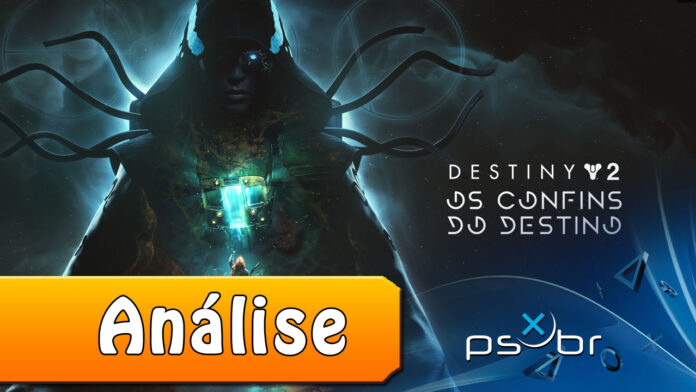Just over a year ago, we were here discussing what was expected to be the conclusion of the grand narrative arc that began nearly eight years ago in Destiny 2. The Final Shape (officially translated into our language as A Forma Final) stands as one of the best and most satisfying expansions in this universe filled with many highs and some lows.
It didn’t take long to discover that Bungie wasn’t ready to abandon the rhythm of major annual releases. Thus arrives The Edge of Fate¸ functioning as both an epilogue to the events of the previous storyline and a new step toward future possibilities for the franchise that refuses to rest.
Set on the entirely new exoplanet Kepler, this journey’s key innovation is the Matterspark Orb mechanic. Essentially transforming us into a spark—an energy orb capable of traversing unique portals and tight spaces—this mechanic gradually reveals additional functionalities throughout the campaign’s 14 missions.
Initially, I had mixed feelings about this new tool, frequently required to overcome bosses and side activities planet-wide. Shifting into a third-person ball of light remains surprising after hundreds of Destiny 2 hours, yet simultaneously felt like an artificial inclusion chasing creative refreshment.
However, after mastering its usage and recognizing genuinely supplemental content built around this form, the adventure flowed better than expected—despite excessive novelty enforcement during moments where I simply wanted to engage alien hordes with my meticulously crafted build.
Narrative cohesion proves equally contentious. Though CGI cutscenes maintain stellar technical quality, new characters lack memorability, and all missions feel like reheated plot servings demanding negligible urgency. It’s a post-party atmosphere where we’re lingering guests oblivious to the festivities’ end.
On the positive front, Kepler is a visually stunning addition to Destiny 2’s consistent art direction. Moving beyond familiar biomes, physical distortions now incorporate temporal shifts that elevate production value. While not revolutionary alone, it’s a welcome expansion to the collective aesthetic.
Enemies follow suit. Despite minimal innovation for long-slaughtered species, variations emerge—some using jetpack-like hovering, others protected by force fields requiring novel Matterspark Orb combat approaches. Subjectively, Destiny 2’s FPS mechanics remain unmatched; even “more-of-the-same” shines brightly.
Accompanying this narrative expansion is a deep overhaul of core power-leveling systems, which may shock players seeing 1900-2000 gear scores reset to basic tiers. We effectively rebuild equipment values while retaining accumulated traits—a jarring but refreshing opportunity to experiment with new builds, elemental weapon classes, or long-neglected gear.
New weapons, particularly exotics like the Graviton Spike hand cannon, New Land Beyond sniper, and Third Iteration rifle, expand deadly loadout possibilities. Special bonuses with armor sets like Aion Renewal’s speed boost further enhance synergy.
Still, unlike previous expansions, The Edge of Fate struggles to justify a game return—especially for lapsed players. It’s a realignment catering to veterans, stray devotees, or newcomers wary of accumulated complexity via a soft reboot that equalizes downward without clear direction.
Whereas The Witch Queen reinvented the game with seemingly irretrievable vigor; Lightfall served as that providential breather; The Final Shape delivered an epic climax to gaming’s grandest tales. Those moments were ideal entry/return points. The Edge of Fate, despite its reboot intent, feels like an expensive extended post-credits scene—akin to cops arriving after heroes resolved the action flick’s conflict.
Looking optimistically, a long-term strategy solidifies here. Developers clearly plan to evolve Destiny 2 as a platform rather than create Destiny 3 after the Light vs. Darkness saga—a Marvel post-Endgame parallel raising concerns.
The new Portal menu section addresses navigation chaos, streamlining Destiny’s patchwork quests, raids, seasonal activities, and hubs into clearer focus. Letting players determine their engagement paths shows crucial awareness of diverse play preferences for sustained relevance.
As evident, my Destiny 2: The Edge of Fate experience proves turbulent. I reconnected profoundly in recent years (despite minimal PvP interest). Solo journeys reveal unimaginable fulfillment of 2013’s original vision—yet narrative accumulation demands immense investment, leaving many Guardians behind.
Sandbox gunplay remains peerless, though layered mechanics flirt with gimmicky overjustification. Technical execution shines splendidly, including impressive Brazilian Portuguese localization despite constant updates.
Ultimately, this DLC adds minimally. More compelling linear content surfaced in free updates. Financial justification depends on player expectations, thriving mainly for those fully invested over the last 4-5 years.
Ironically, this reboot necessitates prior closure yet contradicts its purpose narratively. Uninteresting plotlines, excessive reliance on the new mechanic, and murky future paths define it. Potential brilliance beckons—but presently, this transition pales against past glories.
Destiny 2: The Edge of Fate is available for PlayStation 5, PlayStation 4, Xbox Series, Xbox One, and PC (via Steam) with Brazilian Portuguese subtitles and dubbing. This review was produced playing on PS5 with a Bungie-provided code.




